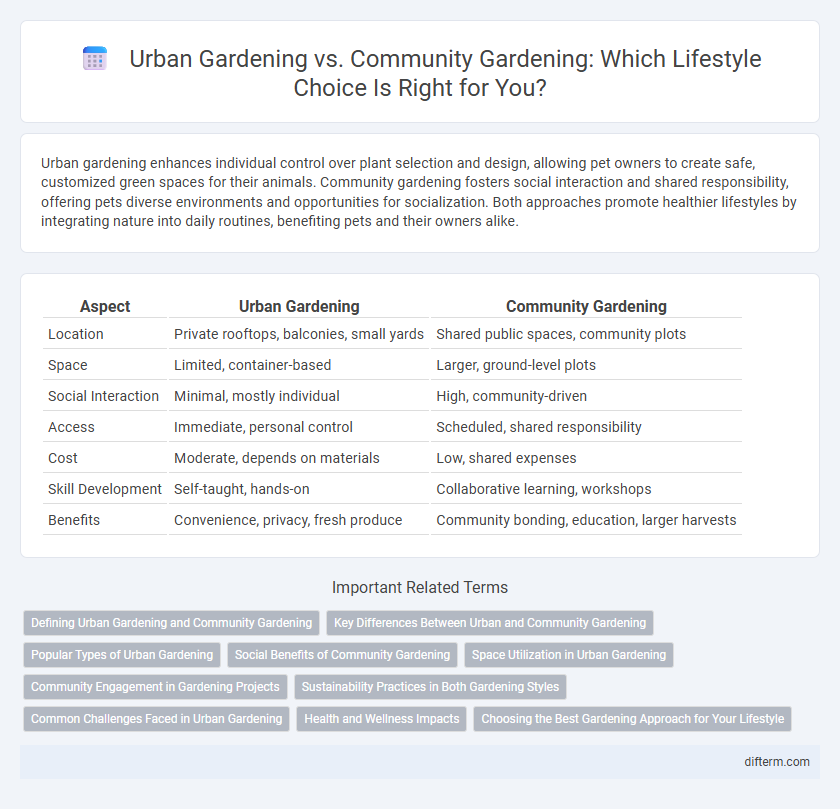Urban gardening enhances individual control over plant selection and design, allowing pet owners to create safe, customized green spaces for their animals. Community gardening fosters social interaction and shared responsibility, offering pets diverse environments and opportunities for socialization. Both approaches promote healthier lifestyles by integrating nature into daily routines, benefiting pets and their owners alike.
Table of Comparison
| Aspect | Urban Gardening | Community Gardening |
|---|---|---|
| Location | Private rooftops, balconies, small yards | Shared public spaces, community plots |
| Space | Limited, container-based | Larger, ground-level plots |
| Social Interaction | Minimal, mostly individual | High, community-driven |
| Access | Immediate, personal control | Scheduled, shared responsibility |
| Cost | Moderate, depends on materials | Low, shared expenses |
| Skill Development | Self-taught, hands-on | Collaborative learning, workshops |
| Benefits | Convenience, privacy, fresh produce | Community bonding, education, larger harvests |
Defining Urban Gardening and Community Gardening
Urban gardening involves cultivating plants in small, private spaces such as balconies, rooftops, or indoor areas within a city, emphasizing personal access to fresh produce and greenery. Community gardening centers around shared plots of land managed collectively by neighborhood members, fostering social interaction and cooperative stewardship of urban green spaces. Both practices contribute to sustainable living, but urban gardening highlights individual efforts, while community gardening emphasizes collective engagement.
Key Differences Between Urban and Community Gardening
Urban gardening typically occurs in limited private spaces such as balconies, rooftops, or small yards within densely populated cities, emphasizing individual cultivation and personalized green spaces. Community gardening involves collective efforts on shared plots, often managed by local groups or organizations, promoting social interaction, resource sharing, and neighborhood improvement. Key differences include scale, governance, and social engagement, with urban gardening focusing on personal convenience and community gardening fostering collaboration and communal benefits.
Popular Types of Urban Gardening
Popular types of urban gardening include container gardening, rooftop gardens, and vertical gardening, which maximize limited space in city environments. Community gardening, by contrast, involves shared plots where neighbors collectively cultivate fruits, vegetables, and herbs, fostering social interaction and local food production. Both approaches contribute to urban sustainability, but container and rooftop gardens emphasize individual expression, while community gardens enhance neighborhood cohesion.
Social Benefits of Community Gardening
Community gardening fosters strong social bonds by encouraging collaboration and shared responsibility among diverse urban residents. These spaces enhance community cohesion, promote inclusivity, and provide opportunities for cultural exchange and collective problem-solving. Unlike individual urban gardening, community gardens create vibrant social networks that improve mental well-being and civic engagement.
Space Utilization in Urban Gardening
Urban gardening maximizes limited space by utilizing vertical gardens, rooftop planters, and balcony pots, making it ideal for densely populated city environments. This approach transforms small, underused areas into productive green spaces, enhancing air quality and providing fresh produce within reach. Compared to community gardening, urban gardening offers personalized control over space design and crop selection, optimizing yield in confined settings.
Community Engagement in Gardening Projects
Community gardening fosters stronger social bonds by encouraging collaboration among diverse neighborhood members, enhancing a collective sense of responsibility and belonging. Unlike urban gardening, which often centers on individual or family plots, community gardens serve as shared spaces promoting educational programs, cultural exchange, and local food security initiatives. These projects increase urban green space while empowering residents through active participation, leading to improved mental health and neighborhood cohesion.
Sustainability Practices in Both Gardening Styles
Urban gardening primarily emphasizes sustainability through efficient space utilization and resource recycling, often employing vertical gardening and hydroponics to reduce water consumption. Community gardening fosters sustainability by enhancing local biodiversity and promoting shared composting, which enriches soil health and minimizes organic waste. Both gardening styles contribute to reducing urban heat islands and lowering carbon footprints by supporting local food production and decreasing transportation emissions.
Common Challenges Faced in Urban Gardening
Urban gardening often struggles with limited space, soil contamination, and water access, making crop diversity and yield difficult. Community gardening faces challenges such as coordinating schedules among participants, maintaining shared resources, and managing differing levels of gardening expertise. Both require effective pest control and pollution mitigation strategies to sustain healthy plant growth.
Health and Wellness Impacts
Urban gardening promotes personal health by providing direct access to fresh, nutrient-rich produce, which supports better nutrition and mental well-being through outdoor activity and stress reduction. Community gardening enhances social wellness by fostering connections, shared responsibility, and collective engagement, which can reduce feelings of isolation and improve overall emotional health. Both practices contribute to physical fitness and environmental awareness, but community gardening uniquely boosts interpersonal bonds and community resilience.
Choosing the Best Gardening Approach for Your Lifestyle
Urban gardening offers personalized control over plant selection and maintenance, ideal for individuals with limited space and variable schedules. Community gardening fosters social interaction and shared responsibility, appealing to those seeking communal engagement and collaborative sustainability efforts. Selecting the best approach depends on your lifestyle priorities, space availability, and desire for social connection within gardening activities.
urban gardening vs community gardening Infographic

 difterm.com
difterm.com